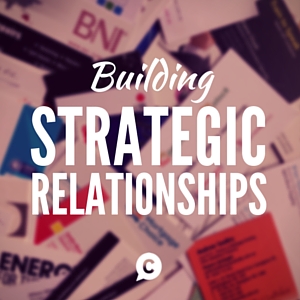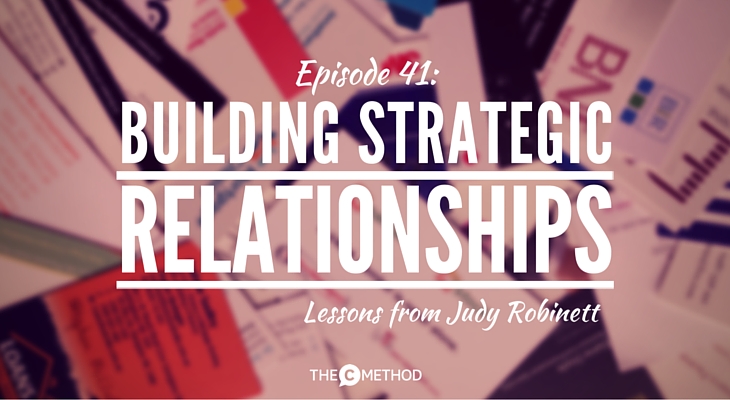This podcast content is for members of The C Method Academy only. The C Method Academy is our monthly members-only training and accountability program. Members get access to exclusive podcast content, Masterclass 'mini courses', Live Coaching Calls and our private community platform. If you want to rapidly develop your confidence, communication and leadership skills, I invite you to join us! Click here to learn more and join The Academy
 Happy New Year, peeps! I hope you’re having a rocking start to 2016.
Happy New Year, peeps! I hope you’re having a rocking start to 2016.
Instead of making resolutions, I like to choose one or two things I’d like to do more of, or do better. One thing I’m choosing to do better this year is:
Managing and nurturing my business relationships.
Having strong relationships and a wide, robust network is critical to the success of any business, including mine. Yet most of us don’t make a real ‘plan’ for managing our connections.
We might have a plan for our money, business, career, meals, fitness…but a ‘relationship plan’? Seems absurd, right?
Anyway, I’ve been inspired by Judy Robinett, who is known as the ‘woman with the titanium digital Rolodex’. She is a business thought leader, speaker and author of the best-selling book ‘How to be a Power Connector – The 5 + 50 + 100 Rule for Turning Your Business Network into Profits’. (non-affiliate link)
Connecting people and building strong relationships is her jam, and I loved the ideas she presented in the book. Getting ‘strategic’ with your relationships may sound contrived and icky, but when done with the right intentions, it’s anything but. Like Michael Denisoff of Denisoff Consulting Group says:
Business relationships are just like any other relationship. They require some effort to maintain, and they must be mutually beneficial. As in any relationship, you must be willing to give, share, and support, not just take or receive.
In this episode I’m sharing 5 key lessons I learned from Judy’s book – and what I’m going to implement. Listen to the episode for more detail 🙂 If you liked this episode, tweet Judy and let her know!
5 Lessons from ‘How to be a Power Connector’
1. Contacts and connections are you most valuable assets
People have the deals, the money, the influence, the power to help you get what YOU want. In the book, Robinett quotes a study that stated that over 89% of senior executives at companies with over $100m annual revenue say that the strength of their personal and professional relationships has a highly significant impact on their ability to deliver business results. Boom!
2. Your network needs to be deep, wide and robust
Deep – knowing people from all levels of influence and power
Wide – your network needs to be diverse. Diversity with industry, location, culture, personal interests etc
Robust – quality connections. Do the people in your network like and trust you? Can you trust them? Will they return your phone calls?
3. The 5 + 50 + 100 rule
Research has shown our brains are only capable of keeping track of up to 150 people. Look at all your contacts and arrange them into the following groups:
Top 5: family and close friends (should be easy)
Key 50: Friends and associates whom you know you can call upon for help and advice. They will answer your calls straight away; you know you can count on them.
Vital 100: People who are important in your life, who add value to you and vice versa. More than a casual acquaintance. There should be a variety of locations, professions, life contexts etc in this group. You should keep in touch with these people once a month at least, even if it’s a tweet, a text or a phone call.
4. Four time frames for following up
As unnatural as it seems, you need to have a “infallible follow-up schedule” for keeping in touch with people.
The 4 time frames are: once a day, once a week, once a month and once a quarter.
Once a day: follow up within 24 hours of receiving an email or message
Once a week: the time frame for when you should check in with each of your Key 50
Once a month: the time frame for when you should check in with each of your Vital 100
Once a quarter: send a group message to the rest of your LinkedIn contacts to let them know what’s been going on with you. And ask them what’s going on with them!
5. How do you know when to add someone to your inner circle?
To help you decide when you meet someone new, Robinett suggests to ask:
- Where did they come from?
- Do our values match?
- Can I provide them with value now or in the future, and vice versa?
&nbso;
The tool I’m using to keep track of my contacts
In the past, I’ve tried to manage my contacts through Gmail, Trello and Excel spreadsheets. But all haven’t really worked for me.
The tool I’m currently using is the Hubspot CRM (Customer Relationship Management).
A CRM is a system that allows you to organise and keep track of all your leads, customers, and other important contacts.
You can sort them my industry, location, whether they’re a lead, customer, evangelist etc. You can write notes about them, you can see your email trail for each contact, and you can log your phone calls, so you can see the last time you contacted them. Then, you can set reminders to call them or email once a month, or every 3 months, or whatever frequency you need to stay in touch.
So far, it’s been excellent and I’m loving playing around with all the features. There are a bunch of other CRM systems around (Insightly, Salesforce, Pipedrive) but I like Hubspot’s because it’s free 🙂
Do you use a CRM?
I’d love to hear what your experience has been! Which one do you use? What is the most useful feature? Any tips for a new CRM user? Leave a comment below, email cc[at]thecmethod.com or tweet me at @cjcanters.

Leave a Reply